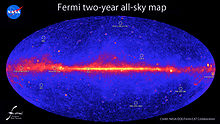Calorimetric Electron Telescope
 | |
| Alternative names | CALET |
|---|---|
| Organization | JAXA |
| Telescope style | space telescope |

The CALorimetric Electron Telescope (CALET) is a space telescope being mainly used to perform high precision observations of electrons and gamma rays. It tracks the trajectory of electrons, protons, nuclei, and gamma rays and measures their direction, charge and energy, which may help understand the nature of dark matter or nearby sources of high-energy particle acceleration.[2]
The mission was developed and sponsored by the
Overview

CALET is an
Unlike optical telescopes, CALET operates in a scanning mode. It records each cosmic ray event that enters its field of view and triggers its detectors to take measurements of the cosmic ray in the extremely high energy region of teraelectronvolts (TeV, one trillion electronvolts).[5] These measurements are recorded on the space station and sent to a ground station at Waseda University for analyses.[6] CALET may also yield evidence of rare interactions between matter and dark matter by working in synergy with the Alpha Magnetic Spectrometer (AMS) – also aboard the ISS – that is looking at positrons and antiprotons to identify dark matter.[2] Observations will be carried out more than 5 years.[7]
CALET contains a sub-payload CIRC (Compact Infrared Camera) to observe the Earth's surface in order to detect forest fires.[8]
Objectives
The objectives are to understand the following:[9]
- origin and mechanisms of acceleration of high-energy cosmic rays and gamma rays
- propagation mechanism of cosmic rays throughout the Galaxy
- identity of dark matter
As a cosmic ray observatory, CALET aims to clarify high energy space phenomena and dark matter from two perspectives; one is particle creation and annihilation in the field of particle physics (or nuclear physics) and the other is particle acceleration and propagation in the field of space physics.
Results
CALET first published data on half a million electron and positron cosmic ray events in 2017, finding a spectral index of −3.152 ± 0.016 above 30 GeV.[10][11]
See also
- List of X-ray space telescopes
References
- ^ "NASA - Fermi's Latest Gamma-ray Census Highlights Cosmic Mysteries". www.nasa.gov. Retrieved 2015-05-31.
- ^ a b c d Dunn, Andrea (9 October 2014). "Dark Matter and Particle Acceleration in Near Space". NASA News. Archived from the original on 2016-09-12. Retrieved 2015-11-10.
- ^ "Hubble Maps the Cosmic Web of "Clumpy" Dark Matter in 3-D" (Press release). NASA. 7 January 2007.
- ^ "CALorimetric Electron Telescope (CALET) – at NASA". Japan Aerospace and Exploration Agency (JAXA). 27 August 2015. Retrieved 2015-11-10.
- ^ a b CALET aboard the ISS Kibo Started the First Direct Electron Observation in Tera Electron Volt Region[permanent dead link]. JAXA Press Release. 22 October 2015.
- ^ CALET USA. Waseda University (2015).
- ^ "CALorimetric Electron Telescope (CALET): Background". Japan Aerospace and Exploration Agency (JAXA). 24 April 2014. Retrieved 2015-11-10.
- ^ "Compact Infrared Camera(CIRC)". JAXA. Retrieved 19 November 2015.
- ^ "CALorimetric Electron Telescope (CALET): Background". Japan Aerospace and Exploration Agency (JAXA). 24 April 2014. Retrieved 2015-11-10.
- S2CID 206301476.
- ^ "First cosmic-ray results from CALET on the ISS – CERN Courier". cerncourier.com. 10 November 2017. Retrieved 2017-11-17.
External links
- [1][permanent dead link] "Status and performance of the Calorimetric Electron Telescope (CALET) on the International Space Station". (PDF) By Roberta Sparvoli.
- [2] CALET brochure in English (PDF) at JAXA.

